|
Laser vision correction is a refractive surgical procedure. Refractive surgical procedures include all of those which reduce refractive error, the inability of the eye to focus properly, due to discrepancies in eye anatomy. These surgical procedures would include the reduction of nearsightedness (myopia), farsightedness (hyperopia), and blurring due to astigmatism (caused by a cornea that is elongated rather than round). Laser vision correction is not ideally suited to correct for both distant and near vision, however, monovision is sometimes an option. With monovision, one eye is corrected for distance and the other for near. Although it sounds unusual, many people accommodate well and, in time, no longer notice that each eye perceives a different segment of their vision.
Dr. Jason Steinfeld provides LASIK, LASEK, and PRK laser procedures for our practice. He offers evaluation at no charge to determine whether laser vision correction is right for you. Your evaluation will include an eye exam, testing for corneal thickness, glare disability, retinal function, and mapping of the cornea. There is a $100 consult fee which will be applied towards your surgery if you are a candidate. If you are not a candidate there is no charge for the evaluation. Before Lasik evaluation you must remain out of contact lenses for one week.
The doctor will fully discuss your diagnosis and his recommendations for the procedure appropriate to your needs. He will be happy to answer all of your questions so that you're completely comfortable with your decision for treatment.
Laser vision correction surgery is performed at both Clear Sight Laser Center and at Riverview Medical Center.
PLEASE NOTE: It is always important that someone accompany you to drive you home following your laser procedure.
 Back to Top Back to Top
LASIK
Millions of people around the world have successfully undergone LASIK surgery. LASIK, which stands for Laser Assisted In-situ Keratomileusis, provides rapid recovery of vision. Although correction is dependent upon each individual case, LASIK almost always provides improvement in vision, reducing or eliminating the need for eyeglasses or contact lenses.
The LASIK procedure is performed using topical (eye drop) anesthetic. There is typically no pain even after the procedure. A thin surface flap is created on the cornea using a fine cutting tool called a microkeratome. This exposes the underlying tissues. The laser beam is applied to this deeper layer of tissue to reshape the cornea and the flap is then placed back into proper position. The exactness of the procedure is due to the exceptional precision of the laser which is programmed prior to surgery.
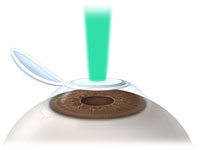
LASIK Laser
|
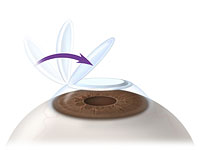
Flap Repositioned
|
Although laser delivery may take slightly longer for patients with farsightedness, it takes less than one minute for most patients. Patients are typically able to return home within one hour of their surgery. Most have both eyes treated during the same appointment.
Full post-operative visual acuity, your full extent of improvement, is generally obtained from within 24 hours to 2 to 3 weeks following the procedure. In particular cases, a few months may be required.
 Back to Top Back to Top
LASEK
LASEK (Laser Assisted Epithelial Keratomileusis) is a relatively new procedure and technically a version of PRK (Photorefractive Keratectomy), which you may also read about in this section. Sometimes referred to as epithelial LASIK or E- LASEK, LASEK is primarily used for patients with corneas that are too flat or too thin to allow LASIK surgery. LASEK was developed to allow the creation of a flap of appropriate diameter or thickness, enhancing the success of the procedure for these patients.
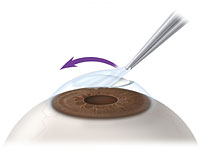
Epithelium Flap
|
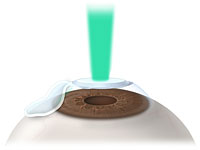
LASEK Laser
|
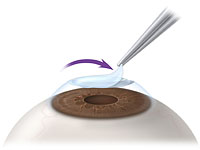
Flap Repositioned
|
Dr. Steinfeld will use topical (eye drop) anesthetic and you should experience no pain during or after the procedure. During LASEK surgery, the outer layer of the cornea (epithelium) is cut with a blade called a trephine which is finer that the microkeratome cutting tool used to perform the LASIK procedure, to create an appropriately-sized flap. The laser is applied to reshape the corneal tissue underneath. The doctor then places the epithelial flap back into proper position.
Your postoperative LASEK experience will be similar to that of LASIK, but some differences do exist. The epithelium takes several days to heal and you will need to wear a bandage contact lens for up to four days. During the first day or two after the procedure, you may experience eye irritation.
Although LASIK surgery often results in the recovery of good vision within 24 hours, it may take longer with the LASEK procedure; perhaps from four to seven days for the quickest results. Be assured that Dr. Steinfeld will always recommend the treatment that is most appropriate to your needs.
 Back to Top Back to Top
PRK
Prior to the development of LASIK, PRK (Photorefractive Keratectomy) was once the original and most common refractive surgery procedure. Results with PRK are more gradual than with LASIK but many doctors prefer this procedure for patients with thin corneas or larger pupils or due to its lower risk factor.
Dr. Steinfeld will apply topical (eye drop) anesthetic and you should experience no pain during or after the procedure. PRK surgery allows the doctor to reshape the cornea through the use of an excimer laser which provides a cool ultraviolet light beam to precisely vaporize the cornea's surface.
The PRK procedure is used to flatten a cornea that is too steep for those who are nearsighted. For those with farsightedness, it helps to create a steeper cornea. And for those with astigmatism, it is used to reshape an irregular cornea.
It may be possible for you to go to work the next day, but the doctor may advise you to rest at home for a couple days. You may also need to forgo strenuous exercise for up to a week to avoid straining the eye. You'll probably wear a bandage contact lens and use prescribed medications for a period of time. The doctor will examine you regularly for a number of days to confirm that the epithelium is healing correctly.
Although the PRK procedure takes a little more recovery time than the LASIK procedure, it is able to provide an equally excellent result for patients who choose it.
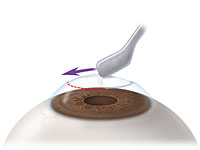
Epithelium Scrape
|
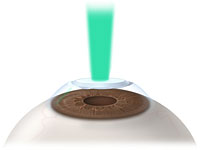
PRK Laser
|
 Back to Top Back to Top
|